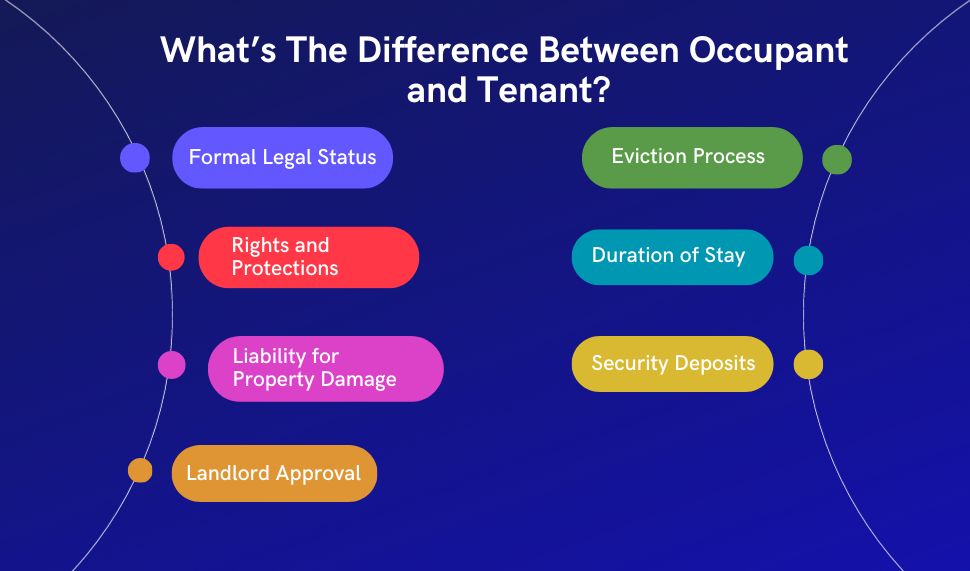Did you know that nearly 20% of landlords have faced issues with unauthorized occupants? As a landlord, you’re likely familiar with how complicated things can get when people live in your rental without proper documentation. One of the most common sources of confusion and legal trouble is misunderstanding the difference between a tenant and an occupant. While the terms often get used interchangeably, especially in casual conversations, they carry very different legal meanings that can affect everything from rent collection to eviction procedures.
As a property management professional with 15+ years of hands-on experience working with Oklahoma landlords, I’ve seen how seemingly small oversights in lease agreements can spiral into major issues. According to the U.S. Census Bureau, there were around 46.1 million renter-occupied housing units in the United States as of the first quarter of 2025, highlighting the ongoing growth in rental activity and the increasing importance of clarity in lease terms. That’s why understanding tenant vs occupant distinctions isn’t just legal terminology, it’s essential knowledge that protects both you and your property.
In this article, I’ll go through everything that you need to know about tenants vs occupants, like how they differ legally, what rights they each have, and how to handle unauthorized individuals living in your property.
Let’s dive in!
Maximize Your Rental Income with Hassle-Free Property Management
Request a Service →Who Is a Tenant?
A tenant is a legal occupant who has a formal rental agreement with the property owner to rent the property. This agreement, commonly known as a lease, is a binding contract that specifies the terms and conditions of the tenancy, including the rent amount, lease term, and tenant’s rights and responsibilities under local landlord-tenant laws. According to Forbes.Com, 45,221,844 total units are being occupied by renters in the U.S., which is 34% of households, highlighting the scale and growth of the rental market in 2025.
For example, John Doe signs a one-year lease agreement for an apartment and agrees to pay $1,000 monthly rent. This makes John a tenant.
Tenants are financially and legally responsible for paying the rent with the right to live in the property without interference from the landlord. They also have the right to maintain the property in a habitable condition. In case of evicting a tenant and terminating the tenancy, landlords must follow proper procedures.
Some factors that make someone a legal tenant include:
- Being a party named on a valid written lease agreement.
- Paying rent directly to the property owner.
- Having documented consent from the landlord to live on the premises.
- Having rights and responsibilities defined under landlord-tenant laws.
- Being able to be removed with appropriate notice.
[Also Read: Reasons to Evict a Tenant From Your Rental Property]
What is the Legal Definition of Occupant?
Depending on the context, the legal definition of an occupant can differ. Generally, an occupant is an individual who is physically present in a property to reside or use it without the landlord’s permission or rental lease. Their permission to live in the rental unit depends on the tenant who holds the lease, allowing them to stay there. However, if a occupant resides without the landlord’s consent, it may constitute a lease violation, potentially complicating the tenant’s legal standing.
For example, Jane Smith is John Doe’s sister. She moves into John’s apartment for a few months but doesn’t sign the lease agreement. Jane is an occupant.
Since occupants are not on the lease contract with the rental owner, they are not financially responsible for the property’s rent, repairs, and maintenance. As well, they do not have the same legal rights and responsibilities compared to tenants. Occupants can also be people living in a property without the landlord’s permission, such as squatters.
Some common situations where one can be considered an occupant include:
- Family members informally cohabit with the lease-holding tenant.
- Guests temporarily residing in the rental.
- Subtenants renting without a sublease contract.
- Unauthorized persons living in the unit without the landlord’s consent.
Breakdown of Unauthorized and Authorized Occupants
Occupants can be categorized into two types, i.e., unauthorized and authorized. So, it’s crucial to understand the relationship between unauthorized and authorized occupants when renting a property.

Unauthorized Occupants: Unauthorized occupants live on the property without the landlord’s knowledge or permission. This could include a friend staying for an extended period without the landlord’s consent or subletting the property without permission. Unauthorized occupants can lead to legal and financial complications for both the tenant and the landlord.
For instance, if John Doe allows his friend, Bob, to live in his apartment without informing the landlord, Bob becomes an unauthorized occupant.
[Also Read: Signs Someone is Living in a Storage Unit]
Authorized Occupants: Authorized occupants have the landlord’s approval to live in the property. They could be family members, roommates, or anyone else listed on the lease agreement or added to it with the landlord’s consent. Authorized occupants share the same rights and responsibilities as the tenant.
If John Doe informs his landlord about his sister, Jane, and the landlord agrees to her living in the apartment, Jane becomes an authorized occupant.
What’s the Difference Between a Tenant and an Occupant?
The difference between a tenant and an occupant is that a tenant has a formal lease agreement granting legal rights to the property, while an occupant resides there without a formal agreement and does not have legal protections. As you can see, they have slightly different legal implications, although they live on the same rental premises. In short, all tenants can be considered occupants, but all occupants can not be regarded as tenants.
Here are some essential differences between occupants and tenants:

Formal Legal Status: The main difference between occupants and tenants is their legal status. Tenants possess legal standing under the lease agreement and statutory rights/protections under landlord-tenant laws. At the same time, occupants lack a formal rental contract and have no legal renting status associated with tenants. They cannot claim these rights.
Rights and Protections: Tenants are protected under landlord-tenant laws covering evictions, discrimination, privacy, habitability standards, etc. Occupants lack these statutory rights. They are subject to the rules and regulations set by the tenant or rental owner, as they do not have a formal agreement directly with the landlord.
Payment of Rent: Tenants pay rent directly to the landlord as required under their lease agreement. Failure to make timely rent payments can lead to eviction proceedings. Meanwhile, occupants pay rent to the tenant (if at all) since they have no direct contractual relationship with the landlord. The financial obligations of occupants depend on the agreement with the tenant.
Liability for Property Damage: Tenants are financially liable for any property damages they or their guests cause under the terms of the rental contract. Occupants don’t carry this same liability to the landlord directly, so the tenant would be responsible for property damages. Their responsibilities are only limited to their own personal belongings and living space.
Landlord Approval: Tenants are approved to rent by the landlord and given legal access. However, the occupants live there without the landlord’s agreement. So, while tenants have a formal legal relationship and clearly defined rights, occupants live in the property without proper screening or approval by the tenant rather than a legal agreement with the landlord.
Eviction Process: Evicting an occupant is easy. The landlord needs the tenant to revoke permission for them to stay. In case of evicting a tenant, the landlord must follow the legal eviction process defined in their lease agreement stated by local laws. Also, learn about what happens if the landlord loses an eviction case.
Duration of Stay: Tenants establish a defined rental period in the lease agreement, such as 6-12 months, providing stability and a predictable living arrangement. However, occupants can technically stay for an unlimited time/period as they do not have to sign a formal contract stipulating a term of residence.
Security Deposits: Tenants are required to pay security deposits to the landlord when signing the lease agreement. Occupants do not pay deposits to the landlord, though the tenant can charge them separately.
Maximize Your Rental Income with Hassle-Free Property Management
Request a Service →Tenants vs. Occupants Rights and Responsibilities

The rights and responsibilities of occupants vs tenants differ, so it is important to be familiar with their respective rights and duties according to state laws when renting a property. These rights and responsibilities are generally outlined in a lease or rental agreement. This will help to have a positive and productive landlord-resident relationship.
Occupant Rights and Responsibilities
Want to know what rights does an occupant on a lease have, right? Although formal lease agreements do not bind occupants, they still have certain rights and responsibilities, which the property owner must respect. However, unlike tenants, occupants do not have the rights and responsibilities defined in a lease or rental agreement.
Respecting Property Rules: Occupants must follow the rules and regulations the property owner or management makes, such as noise restrictions, pet policies, and property maintenance guidelines.
Paying Rent: In certain cases where the occupant is not the tenant, they may be required to contribute to rent payments as per the arrangement with the tenant.
Vacating the Property: Occupants not named on the lease must vacate the property if the tenant terminates the lease agreement, regardless of whether the occupant has paid rent directly to the landlord.
Non-Discrimination: As provided by fair housing laws, tenants are protected from discrimination based on their race, gender, religion, disability, or family status. The landlord cannot refuse to rent or evict them because of one of these protected characteristics.
Privacy: Occupants have the right to privacy within their rented or leased space. Landlords must respect their privacy and not enter the property without proper notice or valid reason, except in emergencies. Also read: Can tenants install a security system without landlord permission
Avoiding Property Damage: Occupants must be careful when using the property and immediately report any damage to the landlord. They are responsible for avoiding damage to the property.
Tenant Rights and Responsibilities
Tenants have more defined rights and responsibilities due to their formal lease agreements. If tenants have a problem with their landlord, try to resolve it directly with them first. If it fails to fix the problem, contacting a tenant advocacy organization or local housing authority is beneficial. Here are some tenant rights and responsibilities:
Payment of Rent: This is the tenant’s most important financial responsibility here. They are legally obligated to pay rent on time and in full accordance with the terms outlined in the lease agreement. They can be evicted if they fail to pay their rent on time. Learn what to do when a tenant stops paying rent and how to handle the situation effectively as a landlord.
Maintenance and Repairs: If the property needs repairs, the landlord is responsible for making them quickly. Tenants can promptly report any necessary repairs to the property manager or landlord. While minor maintenance tasks come under the tenant’s responsibility.
Also Read: Can a landlord make a tenant pay for repairs?
Security of Tenure: Landlords cannot evict tenants without a valid reason and must follow the proper legal procedures. This process usually involves giving the tenant reasonable notice to vacate and then filing a lawsuit in court if the tenant does not leave.
This process usually involves giving the tenant reasonable notice to vacate and then filing a lawsuit in court if the tenant does not leave.
Compliance with Lease Terms: Tenants must comply with all the terms and conditions outlined in the lease agreement, including restrictions on subletting, alterations to the property, and the number of occupants allowed. Breach of contract can create legal action.
Security Deposits: Generally, tenants pay a security deposit at the beginning of the lease. This deposit is refundable, provided the tenant adheres to the lease terms and leaves the property in habitable condition upon moving out.
Quiet and Peaceful Enjoyment: This means that tenants have the right to live in their homes without being disturbed by excessive noise or other nuisances from the landlord or other tenants. Thus, tenant’s peace must be considered a top priority.
[Also Read: Renters Rights in Oklahoma]
Can a Tenant Kick Out An Occupant?
Yes, a tenant can remove an occupant from their leased property, even if the landlord initially allowed them to stay. The lease terms often govern the process of removing an occupant. This is because the tenant has the legal right to control who lives in the space, as defined by their lease agreement. However, the process for doing so must align with local tenancy laws. If the occupant is a minor, the tenant cannot evict them alone.
If the occupant refuses to leave voluntarily, removing them should follow proper legal procedures involving a written notice or formal eviction proceedings.
Also Read: Can a landlord evict one tenant and not the other?
When Does an Occupant Become a Tenant?
An occupant becomes a tenant when they have a lease agreement with the property owner, usually a written lease. In some states, like Oklahoma, staying in a property for more than 5 consecutive days or paying rent can also establish tenancy under Oklahoma law (41 OK Stat § 41-1). This applies even if they don’t pay rent.
Once someone becomes a tenant, they acquire legal rights, protections, and obligations under Oklahoma landlord-tenant laws. The lease also protects the landlord by making the tenant equally obligated to uphold terms like paying rent on time, property damages, habitation standards, etc.; everything is documented in writing to avoid future disputes.
Also Read: When Does A Guest Become A Tenant
Do All Occupants Have to Be on the Lease?
In many rental agreements, listing all occupants residing in the property is crucial to avoid legal issues. This ensures everyone living there is legally bound by the lease terms, including rent payment and adherence to rules. It also helps the landlord maintain accurate records and manage occupancy according to local regulations, which may have limits on the number of residents per unit.
Failing to list all occupants could lead to issues like exceeding occupancy limits, eviction, or difficulty collecting rent. If you are considering adding or removing an occupant from a lease, it is recommended that you consult with a local landlord-tenant attorney.
How Can Landlords Avoid Unauthorized Occupants?
Once unauthorized occupants are established in rental property, removing them legally becomes far more difficult for landlords. A well-written lease contract can help prevent unauthorized occupants. Thus, landlords should take several precautions to prevent unauthorized occupants from residing in their rental properties. Here are some tips to help landlords on how to avoid issues with unauthorized occupants:

Develop a Thorough Screening Process: Verify identity by conducting background checks, credit checks, employment verification, and contacting references of potential tenants planning to reside in the rental unit. Landlords should also require the applicant to provide references from previous landlords. This can help you identify reliable tenants and reduce the risk of unauthorized occupants.
Also Read: How to run a credit check on a tenant?
Create a Well-Written Lease Agreement: The lease agreement should clearly state that only the tenants named in the lease can live in the property. Ensure tenants understand all the lease terms and know the consequences of having unauthorized occupants, such as eviction.
Conduct Regular Inspections: The periodic inspections will allow you to check for unauthorized occupants and identify any potential problems with the property. However, as local laws require, respect the tenant’s privacy rights and provide proper notice before inspections. Also read: What Can a Landlord Look at During an Inspection
Communication: Maintain open communication with your tenants. Encourage them to report any concerns about unauthorized occupants so you can take appropriate action. A good landlord-tenant relationship can lead to tenants being more proactive in informing you about potential issues.
Security Measures: Change the locks on the property after each tenant moves out and install security cameras or other security systems that can deter unauthorized occupants from moving into the property. This makes it easier to identify them if they do move in.
[Also Read: How to kick someone out of your house]
Additional Tips on Managing Tenants and Occupants as a Property Owner
As you have learned to avoid unauthorized occupants, here are the additional tips to manage tenants and occupants effectively, as a property owner, you can take the following strategies:
Respond Promptly to Maintenance Requests: Address maintenance requests quickly to prevent damage to the property. This helps maintain a good relationship with tenants and ensures the property remains in good condition.
Consider Adding Occupants to the Lease Agreement: If an occupant plans to stay long-term, consider adding them to the lease agreement through an addendum, converting them to legal tenant status. This formalizes their stay and ensures they are subject to the same rules and responsibilities as other tenants.
Review and Update the Lease Agreement Regularly: Ensure that the lease agreement reflects the current occupancy situation. Regular updates help prevent legal issues and ensure all parties know their rights and responsibilities.
Final Thoughts on Tenant vs Occupant
In the final word, differentiating occupants vs tenants when renting is important for managing expectations and potential issues around occupancy. A clear lease or rental agreement is essential for managing tenants and occupants effectively. Tenants are the primary leaseholders with a legally binding agreement with the landlord and enjoy full tenant protections.
On the other hand, occupants reside in the property with the tenant’s permission and might have limited legal protections. To ensure a smooth rental experience, landlords and tenants should clearly document and communicate occupancy arrangements.
Differences Between Leaseholder Vs Occupant FAQs
Do occupants have any legal rights?
Occupants generally have limited legal rights since they lack a formal lease. However, occupants may take on certain implied rights if they stay long enough with the landlord’s consent, such as requiring legal eviction processes to remove them. State laws vary in terms of occupant rights.
Is an occupant's duration of stay limited?
Without a lease, an occupant’s stay is technically unlimited, though the landlord or tenant can ask them to leave at any time. To prevent open-ended occupancy, landlords often define limits on the duration of stay for occupants in the primary tenant’s lease, such as no more than 14 consecutive days per visit.
Do occupants pay rent to the landlord?
Occupants do not pay rent directly to the landlord unless the landlord agrees to formally add them to the existing lease. Any rent payments are usually made to the tenant who holds the lease. However, the tenant is still responsible for covering the full rental amount due to the landlord as outlined in their agreement.
Can occupants be added to an existing lease?
Landlords can add occupants to the lease through an addendum, converting them to legal tenant status. This may occur if an occupant plans to stay long term, like a significant other moving in with their partner who holds the original lease.
Does landlord insurance cover occupants?
Each policy differs, but landlord insurance usually only covers tenants named on the lease. Adding occupants formally onto the policy as additional insured individuals may require an incremental fee. Tenants should check their renter's insurance regarding coverage for unnamed occupants.
Can an occupant be evicted by the property owner?
Property owners can ask occupants to leave without formal eviction proceedings since they are not bound by a lease agreement. However, they must provide reasonable notice.
What if an occupant refuses to leave?
If occupants refuse to vacate, landlords will need to follow legal eviction procedures through the court, which can be a lengthy process. It's best to clearly communicate occupant status upfront to avoid such situations.
Can occupants become a tenant?
Yes, occupants can become a tenant if they stay more than 5 consecutive days in the unit according to the Oklahoma state law.
Is an occupant the same as a tenant?
Not necessarily. Although a tenant and an occupant both refer to someone living in a property, they have slightly different legal implications as tenants have certain rights and responsibilities, whereas occupants do not have the same legal protections or obligations.
Can a landlord limit the number of occupants in a rental property?
Yes, landlords can usually limit the number of occupants in a rental property as long as they do so reasonably and within the bounds of fair housing laws. However, they must specified the limitation in the lease agreement to prevent overcrowding and excessive wear and tear on the property.
Does a child count as occupant?
Yes, children are considered occupants because they live in the rental property but do not sign the lease. However, how it can vary, for example, infants are often not included in occupancy limits, while older children usually are.

Author
Scott Nachatilo is an investor, property manager and owner of OKC Home Realty Services – one of the best property management companies in Oklahoma City. His mission is to help landlords and real estate investors to manage their property in Oklahoma.
 (
(









